7 Surprising Things I Don’t Track in My Bullet Journal
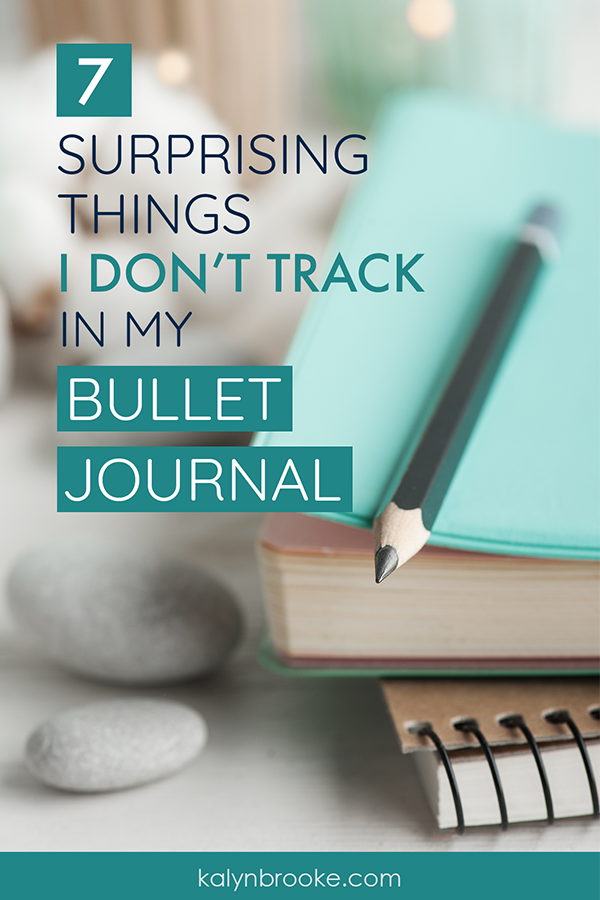
If you’ve been a reader of KalynBrooke.com over the past year, you may have caught on to the fact that I really love my bullet journal. I even wrote a book about how to get started with your own bullet journal!
But I have a confession to make.
I don’t keep everything in my bullet journal.
There are many other areas of my life that I track elsewhere—whether it’s on a digital app, spreadsheet or otherwise!
It’s not that my bullet journal can’t do everything, it’s just that sometimes, there are other systems that do it better. And my goal is to find the best organizing method for everything I do. (I want my bullet journal to work for me, not the other way around!)
So while the bullet journal still carries a lot of weight planning-wise and I would be totally lost without it, these are the things I’ve chosen to take out of my bullet journal and track another way.
1. Monthly / Annual Budget
I currently do all my budget and expense tracking in the You Need A Budget app. I used to use an excel spreadsheet, but decided to give YNAB a try and never looked back! I love how simple the app is to use, and how easy it makes it for couples to share a budget.

While I certainly see the benefits of pen and paper tracking, there’s definitely more potential for hand cramps (and mistakes) which is why I prefer a digital finance system instead.
2. Weekly Grocery List
Rather than keep a running grocery list in my bullet journal, which I then have to pull out and juggle at the grocery store, I use the OurGroceries app. It’s so easy to add ingredients to the list, and the beauty is you can create multiple lists!
I have a list for the groceries that I regularly pick up at either Aldi, Publix, or Winn Dixie, as well as a list for Sam’s Club, since there are certain things I like to buy in bulk there instead.
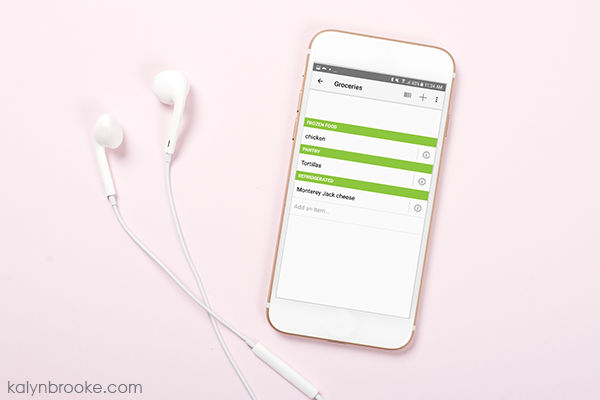
On OurGroceries, you can also categorize your list according to ingredient type: Produce, Pantry, Frozen, Refrigerated, etc, which helps organize your trip around the store. No more running back to the produce aisle because a bag of apples was buried on your list under cereal and baking flour!
Another bonus is the ability to share accounts on your phone with another person. When I add an item, it shows up on Joseph’s OurGroceries app and vice versa.
Related: Psst…here are fabulous tips on how to streamline your grocery shopping so you don’t hate this chore!
3. To-Read List
I used to keep paper reading lists. I even maintained an Excel spreadsheet at one time! But now I prefer Goodreads to keep track of every book I’ve read and all the books I want to read.
If you’ve never used Goodreads before, you create virtual shelves for each of your book categories. You can keep it simple and go with the default Want to Read, Currently Reading, and Read. Or you can mix it up and shelve your books by genre or any category you choose.
You can also rate your books by the number of stars and write a personal review. Any time I look at a book on Goodreads, I always check to see if any of my friends have read it and what they rated the book before I add that book to my own Want to Read list!
Plus, there’s an annual reading challenge you can customize and participate in every year. Goodreads will keep track of your progress and let you know when you’re on track, ahead, or falling behind on your reading goal.
Wondering which book to pick up next? Here’s an easy way to find out!
4. Meal Planning
I started out meal planning in my bullet journal, but later switched to a complete recipe binder filled with printable meal planning sheets and my favorite recipes.
It’s SO easy now to just grab that binder, flip through my recipes, fill out my meal planning sheet and add the ingredients to the OurGroceries app as I go.

Occasionally, I’ll revert back to meal planning in my bullet journal—particularly if it’s a busy week and/or we are gone for most of it, but otherwise, I’ll pull out my recipe binder on Sunday night and plan a full-blown meal plan for the week.
5. Monthly Calendar
I often go back and forth between adding a monthly calendar to my bullet journal and not. Some months I do, some months I don’t. But I can say for sure that I ALWAYS use this calendar app when I’m adding appointments or events (and checking them too!).
Because this calendar syncs with Joseph’s phone and keeps us from scheduling two separate events at the same time, it makes sense to have this part of our lives be digital right now.
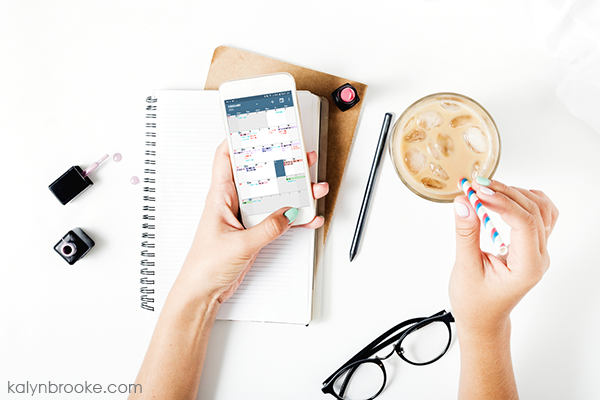
Plus, when events and appointments change, I can easily delete them off the app rather than use white out in my bullet journal!
6. Long-Range To-Do Lists
One of the downsides of the bullet journal is the inability to plan ahead. Because you create one month, week, and day at a time, you can’t just flip over to the next few months to add in future appointments or tasks.
So for any tasks that are more than a week in advance, I use GCal and Todoist.
Todoist is a task management app that allows you to add in a task, assign a date to it, organize it by category (business, personal, etc) and add any notes related to that task.
I just check Todoist every time I set up my current week in my bullet journal as part of my planning routine. Any task that is assigned to the current week will immediately pop up!
I go more into this process (and why I ditched the traditional Future Log) in this post!
7. Business Projects
Projects are one of those things I used to keep in my bullet journal on a Project Page (like I talk about in this post about how to use your bullet journal for work!). And I still do this for personal projects around the home, like organizing my gift wrapping supplies.
But for business projects, I now use Trello.
Trello allows me to create:
- A “Board” for a specific project
- “Lists” (which are the columns seen above)
- and individual “Cards” with each task that relates to the bigger project.
Each of those cards can hold information and links, as well as extra checklists to break that task down even further. Plus, I can assign tasks to individuals on my team and we can communicate back and forth about each card on that card (a feature I love because it streamlines communication!).
My bullet journal can do so many things and I rely on it’s practicalness every single day, multiple times a day. But as much as I wish I could use one tool for everything, that wish is far from realistic! So I let my bullet journal be good at the things it’s really good at and use other tools here and there to fill in the gaps.
As long as a system is working for you, stick with it. But don’t be afraid to switch things up either. Sometimes multiple systems working together is better than trying to force one system to do it all!
And if you need ideas for things to track in your bullet journal, look no further than this comprehensive list of collections ideas!
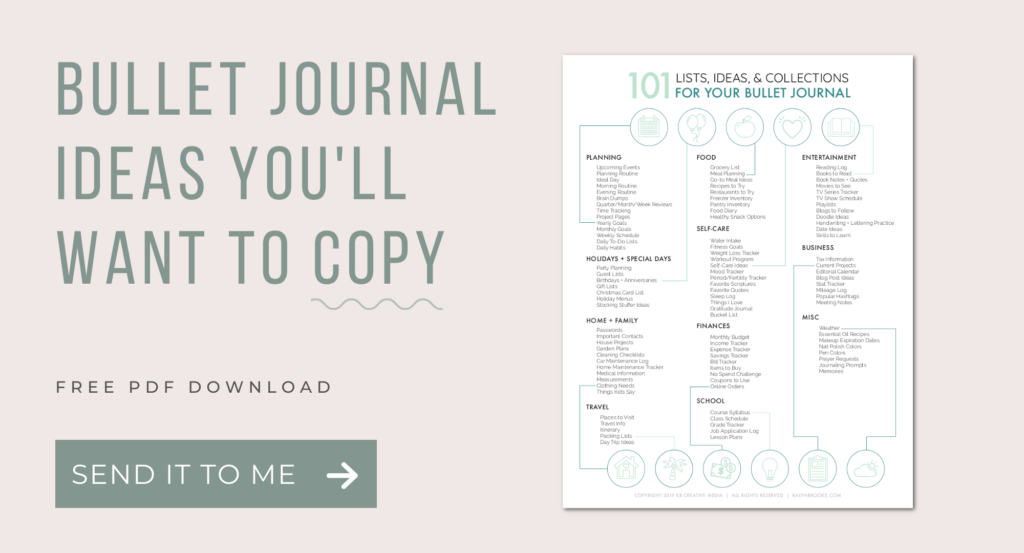
What do you not track in your bullet journal?
Disclosure: Some of the links in the post above are affiliate links. This means if you click on the link and purchase the item, I will receive an affiliate commission. Regardless, I only recommend products or services I use personally and believe will add value to my readers. Read my full disclosure policy here.

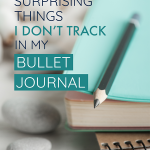



I agree so much with this article – sometimes, there’s a better way than bujo! I love my bujo, and I track all kinds of things in it, using a two-page spread (A5 sized) for each day. I started bujo because I had so many lists, tracking all kinds of things, mostly for medical reasons, and bujo allows me to put them all in one place. Plus, it’s a huge creative outlet for me. But all that said, one of the things I cannot keep in my bujo is my calender. I do write each day’s events on my daily page, and I have a 2-page spread I call my 4-Week page which is a calender holding the name and time of up to 3 events per day (just for quick glancing ahead – I create a new spread every 3 weeks), but the details (where, who else will be there, where do I park, etc.) all go in my iPad calender. I can plan months in advance, and there’s room to write as many notes – or add as many events – as I want. And it’s portable; in fact, I take it almost everywhere I go. My bujo stays at home unless I need to show it to someone (like a doctor). I can always make new entries when I get home. And then I can color code everything with my markers (don’t want to carry those around).
The other thing I don’t bujo is my meal planning. I have a chart set up on my computer for that. I love finding new recipes online and saving them, so they’re handy when I’m planning, and I’ve also computerized a list of favorite recipes to reference. Both that list and the meal planning chart are so easy to erase, rearrange, or cut and paste – paper can’t begin to compete! Once I’m finished planning, I’ll move to my bujo for grocery shopping. I have a 2-page spread with the days of the week and the word “List” around the edges of the pages. Using one small Post-It per meal, I transfer my meals to the bujo. Then, under “List,” I attach a larger Post-It, where I keep a running grocery list for that upcoming week. On shopping day, I just pull my list out and head to the store. When I write the list, I mentally divide it into sections corresponding to sections of the main store where I shop so my list is basically in order. Makes shopping very streamlined! I do have one more step: I write my meal plans on my daily pages when I set them up the night before, just for easy reference the next day. I know it sounds like a lot of work, but I would meal plan/grocery shop no matter what, and the other steps take no time at all.
Thanks so much for taking the time to share your experience, Lisa!
You are right on – everyones journal is going to be different – everyone is going to use it in a different way. And I’m always finding myself inspired to try out new layouts and systems when I see how it’s working for other people. Sometimes they work for my brain, and sometimes they don’t. 🙂
You said you can’t plan ahead in the BuJo, but isn’t that what the future log is for? Or am I thinking of something else?
Of course you can put things in your future-track! I may have worded that a bit poorly. What I meant was, unlike a “standard” planner you don’t have 12 months pre-done so you can look at each months tasks and appointments in a calendar. Because of this I track these events a bit differently – but some put these in their futuretrackers as well. 🙂
Ok, so I just read your other post about how you use Google Calendar and Todoist instead of future log. Then I see here you also use YNAB.
These are the 3 apps I have relied on for years after hyper researching and narrowing down for Todoist and YNAB. It just made me laugh that my first time on your site I see this. An App kindred spirit.
I did also have another app, I think it was called Zapier, which would send new scheduled appointments from Todoist to my Google calendar for me. I later opted to do that manually as it was a bit unreliable.
I found my way here today as I have come back to starting again with Bullet Journaling which I think is the missing gap. I did try to reinvent the wheel with it years ago by creating the spreads on Excel instead of having to manually migrate everything, but I found it cumbersome to have to go to my laptop every time to check my planning. Of course I realize I was trying to cheat the system and go against the actual purpose of it, but I knew I wouldn’t keep up with all the manual entering.
This time I am working on creating as simple but effective system as I can that works for me. I’m merging two ideas.
The 4 page daily with a rolling weekly log with a faux dutch door. Some time blocking sections on those pages as I need this.
Also the 1234 method which categorizes daily tasks and then I do a group of 4 with 1 from each category in a specific order to gain momentum and stay focused. I hope it works out. I think it was an ADHD hack.
It was interesting to read what you said about using digital apps rather than future logs. It seemed to me doubling up if I retained Google calendar, but it works so well for recurring events and birthdays and such.
I think its much safer for me to have noisy digital reminders for the periods where I just don’t look at anything.
I wound up having to switch to a really good customisable reminder app on ios called Alarmed for everything, for a few years. It was only supposed to be temporary to get me through a slump. Now there is about 100 reminders on there a day and even with oodles of different reminder sounds, I’ve finally started to ignore it. So its time for a big rehaul! Thank you for your helpful information.
Wow! Sounds like you have a bit of work ahead of you. I’m glad I could help!